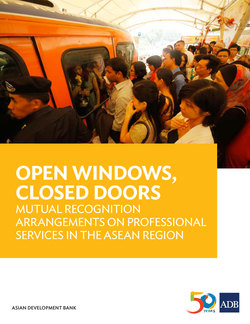Open Windows, Closed Doors

Реклама. ООО «ЛитРес», ИНН: 7719571260.
Оглавление
Guntur Sugiyarto. Open Windows, Closed Doors
OPEN WINDOWS, CLOSED DOORS. MUTUAL RECOGNITION ARRANGEMENTS ON PROFESSIONAL SERVICES IN THE ASEAN REGION
Contents
Tables, Figures, and Boxes
Abbreviations
Acknowledgments
Executive Summary
I. Introduction
II. A Comparison of ASEAN Mutual Recognition Arrangements along Five Dimensions
A. Degree of Automaticity of the Recognition Process
1. Automatic
2. Semiautomatic
B. Degree of Delegation of Authority
C. Degree of MRA Scope
D. Degree of Institutionalization
1. Implementing Offices at National and Regional Levels
2. Type of Stakeholders Involved in Mutual Recognition Arrangement Implementation
3. Human Resource Development Issues
E. Post-MRA Guarantees
III. The ASEAN Mutual Recognition Arrangements: Three Approaches to Mutual Recognition of Qualifications
IV. The Evolution of the ASEAN Mutual Recognition Arrangements: Factors Affecting Design
A. Presence of Preexisting Standards
B. Availability of Financial and Technical Resources
C. Public Safeguards and Differing Realities
D. Protectionist Concerns
V. Moving from Design to Implementation: Tradeoffs and Policy Implications of the Three Mutual Recognition Arrangement Approaches
A. Tourism: Completing the Missing Parts
1. Aligning National and Regional Standards
2. Improving the Quantity and Quality of Training at the National Level Using ASEAN Standards
3. Increasing Industry Endorsement of the ASEAN Standards
4. Completing the Implementing Structure at the Regional Level
B. Accountancy, Architecture, and Engineering: Increasing Scope and Strengthening the Regional Infrastructure
1. Making Compensatory Measures More Transparent
2. Increasing MRA Scope and Flexibility
3. Strengthening the Coordinating Committees
C. Health Professionals: Building Trust and Strengthening the National Infrastructure
1. Creating Umbrella Regional Associations
2. Improving Competency Standards
3. Reimagining the Role of Professional Regulatory Authorities in the 21st Century
VI. Looking into the Future: Maximizing the Potential of Mutual Recognition Arrangements as Tools for Building and Utilizing the Region’s Human Capital
A. Creating Synergy between Mutual Recognition Arrangements and the ASEAN Qualifications Reference Framework
1. MRAs and the AQRF: Mutually Beneficial Processes
2. The Long Road Ahead in Developing National Qualifications Frameworks
B. Linking the Mutual Recognition Arrangements with Existing Mobility Arrangements within ASEAN
C. Learning from the Current Batch of ASEAN MRAs
Appendixes. Appendix 1: Methodology
Appendix 2: List of Participants in Formal Meetings and Individual Interviews
Appendix 3: Affiliations of Stakeholders Who Completed Mutual Recognition Arrangement Implementation Survey
References*
Отрывок из книги
Dovelyn Rannveig Mendoza, Maria Vincenza Desiderio, Guntur Sugiyarto, and Brian Salant
They are also extremely grateful to Supang Chantanavich, Aris Ananta, Paryono, Sothea Oum, Sengxay Phousinghoa, Siti Rosina Attaullah, Ye Swe Htoon, Fernando Aldaba, Shandre Thangavelu, Nguyen Thi Thai Lan, and Jeanne Batalova, for providing their expertise and for directly assisting in preparing and administering the surveys and conducting the focus group discussions and meetings that significantly inform that findings of this report.
.....
Protectionist leanings. The high degree of international mobility and the prospect of employment for tourism professionals within and beyond the ASEAN region drove interest in signing an open MRA framework. In contrast, professionals in regulated occupations threatened by competition, particularly in the health field, were less likely to negotiate such open MRAs, which could potentially exacerbate already saturated, competitive markets.
The open, comprehensive framework of the tourism MRA presents tremendous promise in maximizing opportunities for recognition of ASEAN tourism professionals in the region. However, the approach also has its downsides. It is a huge undertaking to fully implement the tourism MRA, and requires an infusion of resources and capacity building at both national and regional levels. Many of the MRA’s working parts have yet to be completed. At the national level, it is important to complete the alignment of national standards to the ASEAN standards, improve training, and increase buy-in from the private sector. At the regional level, more has to be done to complete the MRA’s grand implementing structure.
.....